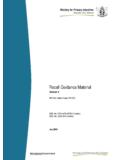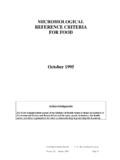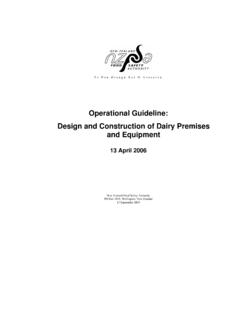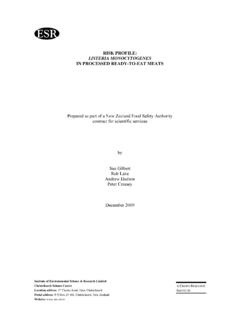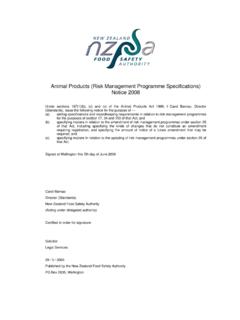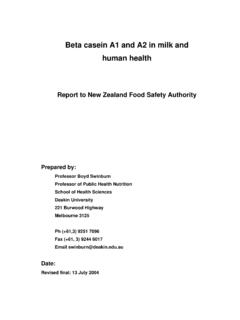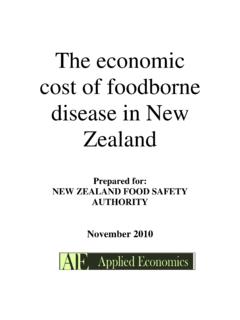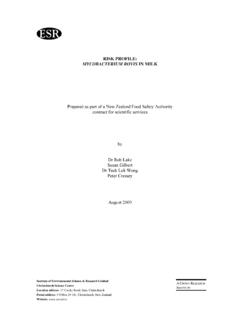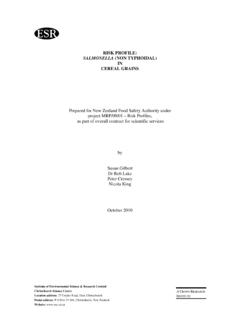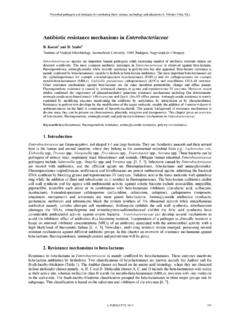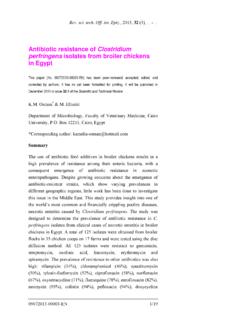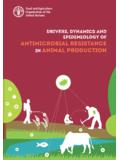Transcription of MAF Technical Paper Template - Ministry for …
1 antibiotic resistance Review and update on New Zealand regulatory control of antimicrobial agricultural compounds with regard to antimicrobial resistance Prepared for Approvals and ACVM Group ISBN No: 978-0-478-38447-5 (online) April 2011 Disclaimer Every effort has been made to ensure the information in this document is accurate. MAF does not accept any responsibility or liability whatsoever for any error of fact, omission, interpretation or opinion that may be present, however it may have occurred. Requests for further copies should be directed to: Approvals and ACVM Group Ministry of Agriculture and Forestry P O Box 2526 WELLINGTON Telephone: 04 894 2550 Facsimile.
2 04 894 2566 This publication is also available on the MAF website at Crown Copyright - Ministry of Agriculture and Forestry Contents Page Summary Background 1 Primary area of concern 2 Expert Panel Review 1999 2 Expert Panel Review 2004 3 Current situation 3 Scope 3 Evidence of antimicrobial resistance 4 International reports on significance of antimicrobial agents 5 World Health Organization (WHO) 5 World Organisation for Animal Health (OIE) 5 Codex Alimentarius Commission (CODEX) 6 New Zealand antimicrobial resistance strategy 7 New Zealand industry and veterinary response 7 Industry 7 Veterinary 8 Review of antibiotic sales in New Zealand (2004-2009)
3 9 In feed/water administration 9 Parenteral or oral administration 9 Antimicrobial resistance surveillance and monitoring 10 Adjustment in New Zealand regulatory control of antimicrobial agents 11 Intramammary administration to control mastitis 11 Oral administration of antimicrobial agents 11 Adjustment in registration information requirements 12 References 12 i Antimicrobial resistance Review and update on New Zealand regulatory control of antimicrobial agricultural compounds with regard to antimicrobial resistance Summary Early last decade, New Zealand adopted a prudent approach to the potential for antimicrobial resistance developing as a result of the use of antimicrobial products in animals.
4 The New Zealand Food Safety Authority (now MAF): removed growth promotion as an acceptable use of critically and highly important anti-microbial active ingredients; imposed veterinary authorisation on any active ingredient it considered to be relevant to the antimicrobial resistance ; and revised the information requirements for registering antimicrobial veterinary medicines to ensure that the potential for resistance was adequately addressed. Subsequent work done by the World Health Organization (WHO), the World Organisation for Animal Health (OIE) and Codex Alimentarius has reinforced the soundness of New Zealand s approach.
5 From an international perspective, New Zealand s low level of antimicrobial resistance was enviable. Now, after ten years of prudent management, recent surveys have confirmed that the prevalence of antimicrobial resistance is still quite low, particularly in regard to the antimicrobial active ingredients identified by WHO and OIE as critically and highly important. During this period the livestock industry sectors have been committed to adjusting management and animal health care practices to reduce dependence on critically and highly important antimicrobial active ingredients. While minor refinements in regulatory control will be made to address innovations and technological advances, New Zealand s current regulatory control of antimicrobials used in animals is considered to be adequate and consistent with international common best practices.
6 Ministry of Agriculture and Forestry Antimicrobial resistance Update 2011 1 2 Antimicrobial resistance Update 2011 Ministry of Agriculture and Forestry Background antibiotic resistance and reduction in the effectiveness of antibiotics to treat certain bacterial infections in humans has been a growing concern internationally. There has always been consensus that the development of resistance is associated with continued use of antibiotics. Evidence suggesting that the development of resistance may be facilitated by use of antibiotics in food-producing animals via the transfer of resistant pathogenic bacteria from animals to humans (or via the transfer of some antibiotic resistant non-pathogenic bacteria with subsequent genetic transfer of the resistance to human pathogens) began emerging as more attention was paid to this possibility.
7 The early evidence was limited, so considerable effort has been taken to gather data needed to put the suggestion into a technically sound perspective. Nevertheless, many countries, including New Zealand, took prudent action to address the possibility of resistance developing. PRIMARY AREA OF CONCERN While the Ministry of Health in New Zealand takes the lead in regard to the prudent use of antibiotics in humans1, MAF is responsible for addressing the issue of antibiotic use in animals. After consultation with experts and interested parties, MAF considered that the primary area of concern was the oral administration of certain types of antibiotics to large groups of food-producing animals such as cattle, pigs and poultry.
8 After ten years of focused investigation around the world, it is still agreed that if resistance is going to develop and transfer from animals to humans, oral medication of large groups of food-producing animals remains the single most likely pathway. MAF s regulatory attention and control of antibiotics has, predictably, focused on prudent use of antibiotics in food-producing animals, with emphasis on in-feed and in-water administration. EXPERT PANEL REVIEW 1999 MAF established the antibiotic resistance Steering Committee in 1999. That committee has commissioned two expert panel reviews. The first one (1999) examined the existing information on antibiotic resistance and New Zealand s regulatory control of antibiotic products.
9 The steering committee made recommendations to MAF and controls on products via conditions of registration for certain antibiotics were adjusted appropriately. However, even at that time in New Zealand, there was very little oral administration of the antibiotic types that were implicated in the potential transfer of antibiotic resistance . Nevertheless, MAF classified certain antibiotic families on the basis of: potential to contribute to resistance ; potential for human exposure to resistant bacteria; and the relative importance of the antibiotic family in human medicine. Growth promotion (or any other production enhancing claims) was prohibited for products that contained antibiotics in the critical family groups.
10 Production enhancing claims were allowed for those antibiotic families that were not implicated in the antibiotic resistance issue. Prophylactic and therapeutic uses of oral antibiotics were allowed, but additional restrictions were imposed for some of the most critical antibiotics to ensure prudent use. 1 Use of antibiotics in humans remains the primary mechanism for the development of antibiotic resistance in humans. MAF imposed a regulatory obligation to report annual sales on all antibiotic products to allow trends in sales (and by implication trends in use) to be monitored. Additional information requirements in line with the VICH Guidance for Industry (Pre-approval information for registration of new veterinary medicine products for food-producing animals with respect to antimicrobial resistance , VICH GL27) were imposed to ensure the potential for resistance to develop was considered and addressed prior to product registration.
